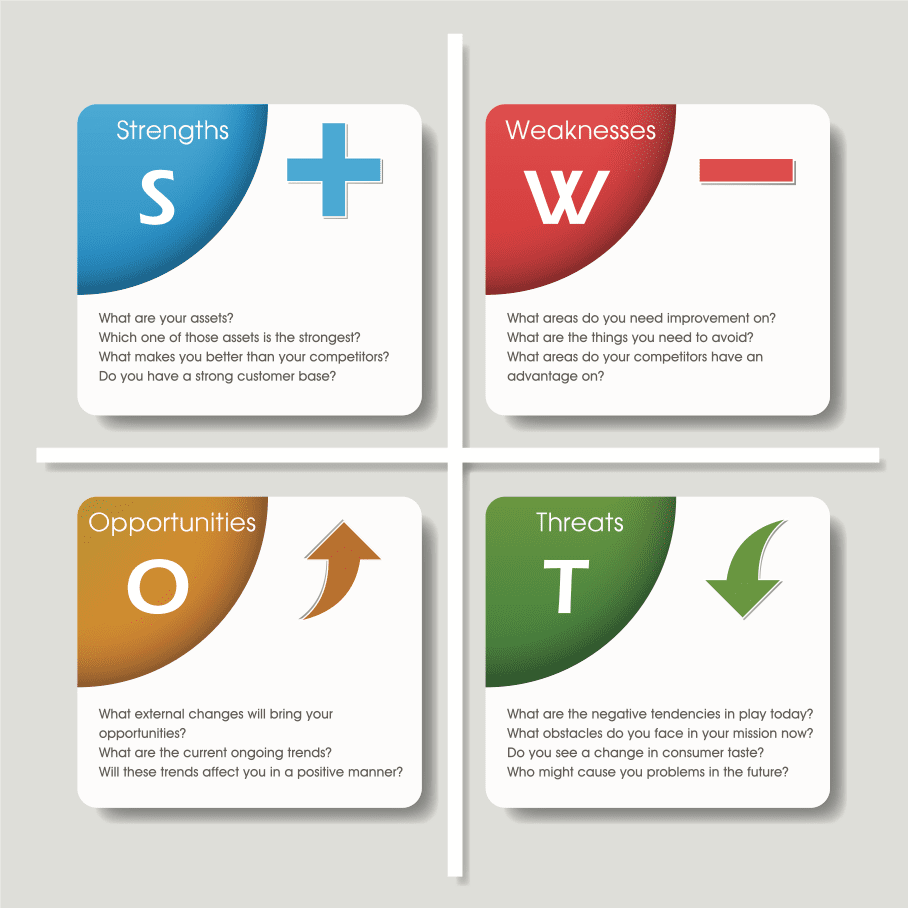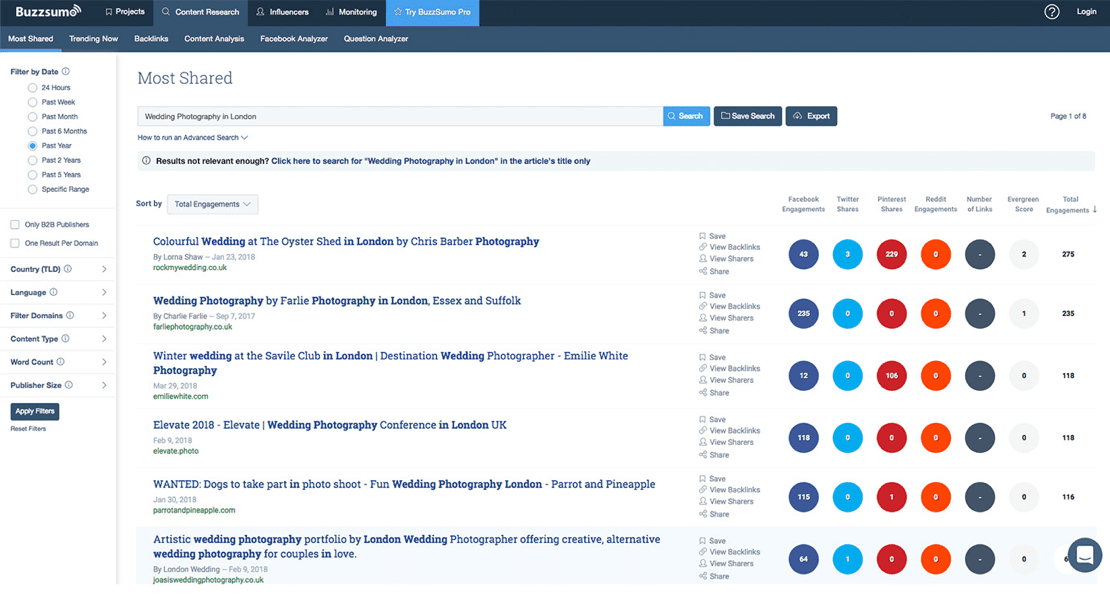Create a strategic plan for getting the most out of your content marketing, including the best tools to use
With 91% of B2B and 86% B2C marketers currently using content marketing, there is no doubt that content accounts for a large part of most marketing strategies today. With 70% of marketers able to show how it has helped to increase engagement and leads, it seems obvious why everyone is investing so heavily in content creation and resources. But if you’re managing or are part of a small business, there isn’t always an endless pot of money for your marketing budget and factors such as time and resources can be limited. So how can you overcome these challenges and still create some killer content?
What I will be looking to cover is exactly this. I will go through the steps you need to take to create a strategic plan for getting the most out of your resources and ultimately, your content. The areas I will cover are:
- Identifying your strengths, weakness, and resources
- SWOT Analysis
- Reviewing internal resources
- Conducting an external analysis
- Setting goals and objectives
- Creating buyer personas
- Deciding on what content works best for you
- Video
- Infographics
- Quizzes
- E-shots
- Podcasts
- Getting the most out of your content
1. Identify Your Strengths, Weaknesses & Resources
Before you start investing time, money and manpower into creating content, it’s important that you evaluate your businesses situation. All businesses have their own strengths and weaknesses and this can have a big impact on what type of content is not only possible but relevant to your audience. By taking the time to review your resources and capabilities you can take a strategic approach that ensures you create content that will “wow” your audience and fulfills your needs.
To help you in knowing what to consider, I’ve outlined some key areas to analyze and how you can go about doing this.
A SWOT analysis is an easy and effective way to quickly identify key information that will impact the approach you will take. Using the classic matrix, you can analyse your strengths, weaknesses, opportunities and threats and gain an overview of what is not only possible but what you can achieve through a content strategy.
For example, if you find new opportunities to cross-selling or enter new markets, you may consider focusing on producing content that aims to promote new products or attract a new target audience. Similarly, if you have a strong social following, you might try to leverage your strengths to focus on creating visual content that performs best on social platforms.
Review Your Internal Resources
With content no longer being restricted to blogs and whitepapers, businesses can now deliver content that is a lot more creative and engaging. But with equipment and software proving costly, not everything is possible for small businesses. For instance, creating videos, animations, and podcasts is incredibly effective in today’s market, but just one professional video can consume a large chunk of your budget.
Therefore, it’s important that you review your internal resources before planning, to ensure you both have the resources and the budget to back up your strategy. Consider whether you have the time, budget, manpower, equipment, and capability to deliver the project effectively and efficiently.
Conduct an External Analysis
It’s important to remember that just because you’re a small business it doesn’t mean that you can’t still have big ideas. If your internal resources are limited, you should always assess what external resources are available to you.
Whether it’s an external agency or an experienced freelancer, looking at alternative ways to create content can be a cost-effective way to still achieve your goals. For example, if you know that a short video is the best way to either engage your target audience or deliver a message, it may be worth researching the cost to work with external videographers. Never compromise so much so that your idea will no longer be impactful and purposeful.
Similarly, analyzing your competitors’ content can be a good starting point before planning a project. With so many tools available on the market today, you can easily find out what their best performing content is and collect valuable data.
By getting a better understanding of their content marketing efforts you can both identify what has proven to work well with your target audience and seek out opportunities to try something different. Both are essential to creating a strategy that continues to connect with existing and new customers, whilst remaining competitive.
Set Clear Goals and Objectives
After analyzing your situation and assessing what resources you have, you should look to set clear goals and objectives. As with any strategy or plan, they play a vital part in ensuring each piece of content supports your wider business objectives. Whilst each piece of content will have its own purpose, and whether it’s to sell, entertain or inform, they all need to align as part of a structured plan and focus on one end goal.
To ensure you start off on the right path, it’s best to set SMART goals; making sure they are specific, measurable, actionable, relevant and time-bound. If you’ve highlighted pain points around key factors such as time, budget or capabilities, you must take these into consideration. If you’re unrealistic from the start you could face issues when it comes delivering quality content and desired results as well as understanding what actually works well for your brand.
The most common content marketing goals for businesses centre around:
- Awareness
- Engagement
- Lead generation
- Lead nurturing
Setting goals is not always as simple as it sounds. It will take time and practice to perfect and ensure your goals are challenging yet achievable. But the important thing is remembering to set some to retain focus, drive the results you want and most importantly, track your progress.
If you want to understand more about setting objectives, you should take a look at this helpful post on how to define SMART marketing objectives.
2. Create buyer personas
Once you have outlined a clear goal and objective, it’s time to start thinking about your customers.
Detailed buyer personas should sit at the heart of any content strategy, as without them, you can’t expect to understand in detail what your audience needs and responds to. By creating a buyer persona, you can get better insight into what might grab their attention and influence their purchasing decisions. In fact, studies have shown that 60% of buyers are inspired to seek out a product after reading content about it, so understanding your audience undoubtedly pays off.
A lot of businesses think they know their audience inside out. And whilst they may know the general demographics and details, there is a lot more to be discovered with data. Building a persona based on assumptions and stereotypes can often be a mistake. Instead, investing time in to building customer databases, email lists, website data and buying consumer data will prove to be worthwhile. Or, if there’s room in the budget, why not consider purchasing consumer and demographic data and start to build a more comprehensive profile?
The more you learn about your customers (their personality traits, values, attitudes, interests, lifestyle etc..) the more targeted your content can be. And the more specific and targeted the content becomes, the higher the chance of engagement.
3. Deciding on what type of content will work best
Like many other digital areas, the world of online marketing is constantly changing. A successful content strategy no longer only consists of blogs, it can now be enriched by engaging videos, infographics and audio material. But with so much choice and competition, knowing what type of content will work best for you can be a difficult task.
To help you to make a strategic decision about what type of content you should be incorporating into your strategy, here are some of the most popular types, their benefits and some useful tools to use.
Video Content
Since the introduction of smartphones and with the ever-growing popularity of social media platforms, video content has fast become the most powerful form of online content. So much so, that Wordstream has stated that one-third of online activity is currently spent watching videos and by 2021, 82% of all internet traffic is estimated to be video traffic.
But most importantly, not only are consumers choosing to engage with videos, they are then purchasing more. Studies have shown that marketers who use video content, grow revenue 49% faster than those who don’t. So it’s also no surprise that 51% of marketing professional name video as the type of content with the best ROI.
But whilst the results are undoubtedly very appealing, creating high-quality videos can seem unachievable to most small businesses. Having the time, skills and tools is a common pain point and stop many marketers from even considering video. However, if you do your research, you’ll discover that there are some great tools and apps out there that can make what seems impossible, possible.
Useful Tools To Consider:
- Videoshop Price: £1.49. As one of the most popular video apps amongst those on a low marketing budget, Videoshop enables you to create a great-quality video using your smartphone or tablet. With a wide range of features including, video effects, text overlays, voiceovers, music, sound effects, slow-motion and many more, you can create engaging videos without any professional input or great expense.
- Magisto Professional Package $9.99 pm – Business Package $34.99. Powered by A.I, this app is great for those short on time and videography skills. In just three simple steps you can create quality video content that includes music and video effects. Simply upload your videos or photos, choose a video editing style and a soundtrack from the library and then the A.I powered video maker will analyse and edit your video.
- Adobe Premier Pro CC £19.97 a month as part of the Adobe Creative Cloud package. If you’re serious about video content, it may be worth regularly investing in professional software and equipment. Adobe Premier Pro is a professional video editing software that has a clean interface, flexible trimming and advanced editing features. However, as it is designed for creative professionals, it may seem difficult to use at first and will require time and practice to perfect.
Infographics
As humans, we are more likely to not only engage with but also remember visuals. In fact, 65% of us are visual learners. Therefore, combining words with engaging imagery and colours in the form of an infographic can be very impactful.
Most commonly used to present facts and figures around a particular topic, infographics are relevantly easy to create. With plenty of online websites and free apps available, creating a professional looking infographic is not as hard as it seems. Once you have collected your information, produced copy and collected some images, you can quickly turn this into an infographic.
Besides being inexpensive to create, they are a good example of content that can be used across multiple channels, multiple times – helping small businesses save valuable time, money and resources.
Useful Tools To Consider
- Visme Price: Basic Package – Free. With over 100 free fonts, millions of free images and thousands of quality icons, Visme creates infographics in minutes. With an upgraded package, you can also include video, audio and animation to maximise the visual impact and make your infographics more engaging.
- Canva Price: Basic Package Free or Cava for Work from $9.95/m. Priding itself on being for ‘non-designers’, Canva is a great website for designing infographics with a simple drag-and-drop functionality. With lots of free dedicated features, you can also use it to produce a wide range of design tasks, from brochures to presentations and much more. With their Canva iPad app, you can also design whilst on the move – making it very easy to find time to create content.
- Google Charts Price: Free. As a free web service provided by Google, you can create professional graphical charts using your own personal data. Like most of Google’s other free tools, Google Charts is easy-to-use and enables you to create colourful graphs that are clear to read and more engaging for your audience.
Ebooks / Guides / Magazines
Often considered as one of the most comprehensive sources of information in content marketing, ebooks, guides and online magazines are becoming increasingly popular amongst marketers. Besides providing lots of useful information, they provide an easy opportunity for securing backlinks and getting branded content shared online.
The idea of creating either a book or magazine seems like one hard slog, but in reality, it can be much easier and quicker than you think. With access to a small number of either internal or external copywriters, you can invest the time it would take to create several smaller blogs into making one, really high-quality and purpose-driven piece of content. And, if you’re working to a really tight time-scale, you could consider recycling a series of related blogs or articles into a very useful ebook or guide.
All you need is time, manpower and a handy tool to bring everything together.
Useful Tools To Consider:
- Google Docs Price: Free. Providing an easy way to create ebooks, Google Docs is probably the most cost effective solution. Simply produce your copy, convert a doc. into a pdf and upload to your website, e-shot or blog. Whilst it lacks interactive features and the option to embed video, it’s still relatively easy to use.
- Adobe Indesign Price: £19.97/mo. Incl VAT. If you have an in-house design team, they will most likely use Adobe Indesign for their creative projects and therefore is an easy solution for you. Besides allowing you to create stunning visuals, you can also embed video and incorporate interactive features such as page turning. If you’re familiar with the software, it can be a great way to create professional looking content at a relatively low cost.
- Issuu Price: Free. If you’re looking to create something more similar to a magazine, Issuu is a tool worth considering. In addition to being quick and easy to use, Issuu is loved for turning pdfs into good-looking online publications/magazines and comes with useful features such as page turning and zooming capabilities. You can embed the content into your website and easily share it on social media platforms directly from the website.
Quizzes

Quizzes are a quick and easy solution to creating content that is fun and engaging for your users. However, with the purpose of providing some light entertainment for your audience, it is worth considering how beneficial they will actually be. Whilst they don’t require much time, money or manpower, they should only be used in moderation.
If you wanted to get the most out of your quiz, you could direct traffic onto more useful content or find a way to collect an email address for your database.
Useful Tools To Consider:
- SurveyMonkey Price: Basic Package is FREE but limited. Starts from £35pm. As one of the most well-known platforms for creating free surveys and quizzes, SurveyMonkey is incredibly easy to use for both marketers and quiz goers. After creating your quiz online you can then share it on your website and social platforms.
E-shots
Email marketing has long been considered a classic tool in digital marketing and with the growing trend to deliver personalized campaigns, e-shots are still as effective as ever before.
Combined with an enticing subjective line, creating visually attractive e-shots help to both increase customer engagement and generate valuable leads. With one e-shot marketers can push their brand and product directly into the inbox of their target audience and encourage a number of actions.
With loads of free or relatively cheap email marketing platforms available, content marketers are able to promote content to a wide audience in a way that is both time-efficient and cost-effective. Therefore, email marketing should play an important part in strategies for small businesses.
- MailChimp Price: Basic Package – FREE. Arguably the most popular email marketing platform, MailChimp is great for all marketers. With several packages available you can benefit from multi-user accounts, custom branding, live chat and email support, flexible targeting options and a/b testing functionality.
Podcasts

Much like infographics, podcasts add an extra dimension to your content marketing efforts. Whilst infographics are focused on the visual aspect of content, podcasts are focused on providing useful and engaging audio content.
Helping your online audience to take in valuable information whilst on the go, podcasts can be a valuable marketing tool. By discussing a given topic in detail, they can help to draw and maintain the attention of your target audience. In addition, podcasts are also a useful way to demonstrate your expertise, helping to build authority, increase brand awareness and attract buyers.
Although creating high-quality podcasts may require some limited hardware and software tools, if you’re sure that this is the best way to connect with your audience, a one-time investment could provide long-term results. However, for those who can’t afford the initial expense, there are now some free apps available.
Useful Tools To Consider:
- Anchor Price: Free. Described as the easiest way to start a podcast, Anchor is one of the best apps on the market. Besides being able to record, edit and share your content all in one place, you are also able to record with a co-host in another location, review analytical data and automatically distribute your podcast to major platforms such as Apple Podcasts and Google Play Music.
4. Getting the most out of your content
Once you have considered all the different possibilities, you need to seriously think about what will
deliver the best results for your business. With so much variation in what you can create, it is easy to forget what matters most – your goals, resources and capabilities.
To create a successful content strategy you need to remind yourself of what will not only be achievable but worthwhile. After thinking of different ways in which you can create quality content, you need to see how they can align to your business objectives and each other. By mapping out your plan for each piece of content you can quickly see how you can create a multi-channel strategy that supports your main goal.
Despite being one of the most important parts of delivering a content strategy, many businesses fail to set and proactively track performance data and metrics. In fact, one study found that 80 percent of small business owners set up goals but did not keep track of them. In order to get the most out of your content, it’s essential that you look into how it is performing both throughout the campaign and before starting continual improvements.
Some key metrics you should consider:
- Leads
- Engagement (Time spent on page)
- Bounce Rate and Exits
- Social Shares
- Number of backlinks
Once you have a clear insight into which metrics are important to track for each content type, you can make an informed decision about what to do next. You can learn more about your target audience and see whether you need to amend your strategy.
With there being many benefits of using content marketing, it’s important as marketers to understand what could work for you. By understanding the different types of content and the tools that are available, you can find new ways to make your content go a long way on a small budget and time constraints.


